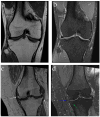Minimally Invasive Therapies for Knee Osteoarthritis
- PMID: 39338224
- PMCID: PMC11432885
- DOI: 10.3390/jpm14090970
Minimally Invasive Therapies for Knee Osteoarthritis
Abstract
Knee osteoarthritis (KOA) is a musculoskeletal disorder characterized by articular cartilage degeneration and chronic inflammation, affecting one in five people over 40 years old. The purpose of this study was to provide an overview of traditional and novel minimally invasive treatment options and role of artificial intelligence (AI) to streamline the diagnostic process of KOA. This literature review provides insights into the mechanisms of action, efficacy, complications, technical approaches, and recommendations to intra-articular injections (corticosteroids, hyaluronic acid, and plate rich plasma), genicular artery embolization (GAE), and genicular nerve ablation (GNA). Overall, there is mixed evidence to support the efficacy of the intra-articular injections that were covered in this study with varying degrees of supported recommendations through formal medical societies. While GAE and GNA are more novel therapeutic options, preliminary evidence supports their efficacy as a potential minimally invasive therapy for patients with moderate to severe KOA. Furthermore, there is evidentiary support for the use of AI to assist clinicians in the diagnosis and potential selection of treatment options for patients with KOA. In conclusion, there are many exciting advancements within the diagnostic and treatment space of KOA.
Keywords: AI for knee osteoarthritis; genicular artery embolization; genicular nerve ablation; knee osteoarthritis; regenerative and experimental therapies.
Conflict of interest statement
N. N. owns IRAD Graphics and Info Med Solution, and consults for CAPS Medical and Boston Scientific.
Figures





References
Publication types
Grants and funding
LinkOut - more resources
Full Text Sources

